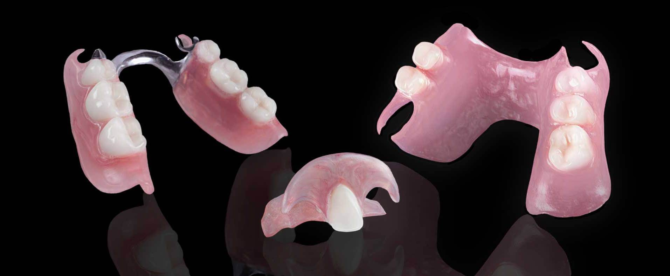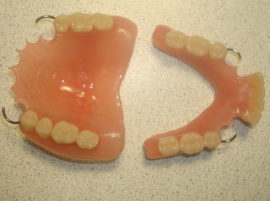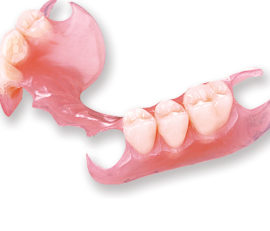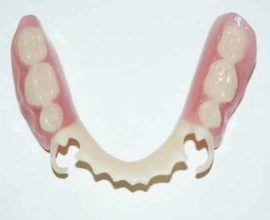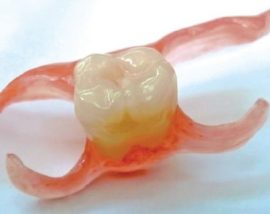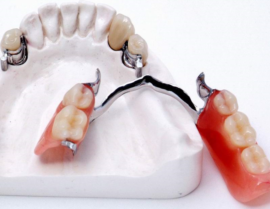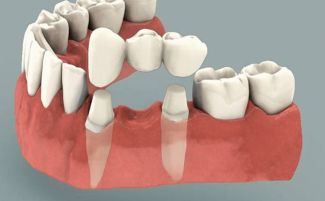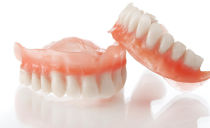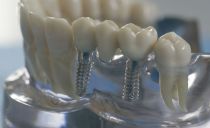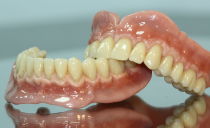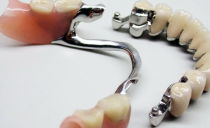Removable and non-removable dentures with partial absence of teeth: types and photos
Incomplete dentition creates difficulties not only in communication, but also during chewing food, which disrupts digestion. Therefore, with tooth loss, it is necessary to restore the integrity of the dentition by means of prosthetics. In case of partial absence of teeth, it is preferable to install fixed dentures, but sometimes it is better to choose removable ones.
Content
What is partial removable prosthetics when applied
A removable denture is a design that can be removed and worn on its own, without the help of a doctor. If not all teeth are prosthetized, but several, such a design is partial.
This type of prosthetics is indicated in the absence of one or more teeth. The integrity of a partially incomplete dentition can be restored by installing an implant or a bridge, but if there are contraindications to non-removable prosthetics, a partial denture is used.
In the absence of almost all teeth, the installation of a fixed structure may be recommended. Removable dentures attached to the remaining teeth may not provide an even distribution of the load on the jaw.
Types and photos of removable dentures with partial absence of teeth
Depending on the available indications and contraindications, the level of equipment of the dental clinic and the financial capabilities of the patient, prosthetics with partial absence of teeth is performed in several ways:
| Type of prosthesis and photo | Short description |
|---|---|
|
Partial removable plate |
A plastic or acrylic base on which crowns are mounted. Such removable dentures are attached using clasps or locks. As the plastic wears out, additional layers of material are required. The service life of the product depends on the condition of the bone tissue of the jaw. |
|
Nylon |
A nylon construction resembling acrylic. It is used for prosthetics of one or several teeth. |
|
Polypropylene |
The design is similar to nylon, but more durable. |
|
Immediate prosthesis |
Butterfly-shaped temporary use design. Designed for prosthetics of one or two missing teeth. Contains an acrylic or nylon base with hooks secured to abutment teeth. |
|
Clasp |
A structure having a metal base to which a plastic base and crowns are attached. For the manufacture of a cast base, titanium or alloys are used, which may include chromium and cobalt, platinum and gold. It is fixed on hooks, locks or telescopic crowns. Set if the teeth are partially missing. |
|
Removable prosthesis without sky |
Modern design called "sandwich". It consists of an acrylic rigid base and elastic polyurethane crowns that are attached to existing chewing teeth. |
Advantages and disadvantages of acrylic, nylon and polypropylene prostheses
Acrylic, polypropylene and nylon prostheses differ in both advantages and disadvantages:
| Denture name | pros | Minuses |
|---|---|---|
| Partial removable plate |
Allows you to evenly redistribute the load on the jaw. Fast manufacturing, easy installation and easy maintenance. Hard plastic products are cheap, soft ones are comfortable. Fastening with locks is preferable than with clasps. |
Hard plastic products are rough, soft ones are expensive. May provoke speech defects, discomfort, and pain when used. The clasp mount quickly deforms, which increases the load on existing natural teeth. Their chewing surface deteriorates, toothaches and headaches occur. Due to microporosity, it is impossible to completely clean the prosthesis from plaque. Short service life - 4–5 years. |
| Nylon |
Hypoallergenic, more flexible, less likely to cause discomfort. Quick adaptation. Hooks have a shade similar to the color of the gums, so they are hardly noticeable. |
Product flexibility can accelerate bone atrophy. As a result, the structural fixation strength will decrease. Unevenly distributes chewing load. Relocation is not carried out. |
| Polypropylene |
More durable and reliable than nylon. Less often correction is required. |
The complexity of relocation. It is installed only if the dental units are missing partially (no more than 3). |
| Immediate prosthesis | Nylon constructions are hardly noticeable. | Not intended for permanent use. |
Which prosthesis is better - clasp or sandwich?
Clasp prostheses and “sandwiches” are widely advertised, but each of them has both advantages and disadvantages.
| Denture name | pros | Minuses |
|---|---|---|
| Clasp |
Evenly distributes the load on the jaw. More convenient than a plate prosthesis. When fixed to locks or telescopic crowns it is hardly noticeable. Able to eliminate the mobility of existing teeth. Durability and reliability. |
High cost, more complex manufacturing. When installing, it may be necessary to turn natural teeth. |
| Sandwich | Not so massive, does not violate the perception of taste and pronunciation of sounds, does not provoke vomiting. |
Polyurethane crowns are very thick. Low strength and stability. May cause discomfort. |
Despite the fact that constructions without a sky are considered the most modern, they have very important disadvantages that appear during use. The most significant drawback of clasp dentures is the high price, but in many situations they are the best choice for partial dentures.
Conditionally removable dentures
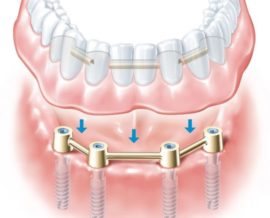 Conditionally removable prostheses are fixed using intra-channel implants. This method of prosthetics is used if the patient lacks many teeth, and the remaining units have poorly preserved crowns.
Conditionally removable prostheses are fixed using intra-channel implants. This method of prosthetics is used if the patient lacks many teeth, and the remaining units have poorly preserved crowns.
Conditionally removable prostheses consist of two parts:
- top with artificial teeth;
- bottom with fasteners - buttons, spherical or equatorial abutments.
They can be removed, but with more effort, or only in a clinic. Due to this, the risk of their accidental loss is reduced.
The plastic base of conditionally removable dentures is smaller and does not block the sky, which makes them more comfortable to wear.
Fixed prostheses
Fixed prostheses are made of different materials and differ in design and installation method. Their only common feature is the impossibility of self-removal.
Varieties of fixed prostheses:
- Crown. It is established if the root of a dilapidated tooth has retained functionality.
- Bridge prosthesis. The design of several crowns. Extreme fasten to healthy teeth used as a support.
- Veneer and lumineer. Thin plates attached to the anterior surface of the teeth. They resemble false nails in shape. They are installed to improve the appearance of the teeth, and not to replace them.
- ImplantIt consists of a fixed pin that replaces the root of the tooth, and a crown. The pin is made of metal and screwed into the jaw bone, the crown is fixed on top.
Photos of fixed dentures used for partial absence of teeth
How partial dentures are made - stages
Correction of the dentition by installing partial removable dentures begins with an initial visit to the dentist and determining the condition of the oral cavity. If inflammatory dental diseases are detected, oral cavity sanitation is performed. Then the doctor and the patient begin to choose the prosthesis and the material used for its manufacture.
The steps for making a partial denture include:
- Create a dental impression on silicone or light curing material.
- The manufacture of the workpiece, which is subjected to recheck and fit.
- The manufacture of the main structure. The duration of this period depends on the type of prosthesis.
- Fitting the prosthesis. The patient should check whether there is discomfort, whether the bite is distorted, whether the prosthetics and their own teeth are closed normally.
The technique and stages of installing the finished prosthesis depend on the type of prosthesis chosen.
Partial dentures care
The prosthesis fixed in the oral cavity must be looked after. You need to clean it with a paste using a specially designed brush with double-sided bristles and periodically disinfect it with a special solution that the dentist will recommend. It is impossible to expose the product to other chemicals, otherwise you can spoil the design and cause harm to your health.
To make the removable denture last longer, it is not recommended to chew it with solid and viscous food. After eating, you must rinse your mouth with water.
Periodically, you need to carefully inspect the product for cracks. If they are found, you should contact the dentist. In no case can you repair or grind the surface of the structure yourself. With its deformation, the chewing load will become uneven, as a result, the alveolar processes of the jaw can atrophy. Twice a year you need to visit dentistry for a routine examination.
With a partial absence of teeth in any part of the lower and upper jaw, the integrity of the dentition can be restored through prosthetics. Clasp dentures lead in the number of advantages, so in many cases they are preferred. But with a lack of finance, it is better to choose a product from acrylic or nylon. With proper manufacture and proper installation, wearing it will be comfortable, and the life of any prosthesis can be increased by a careful attitude.

